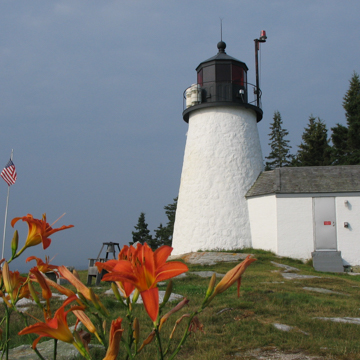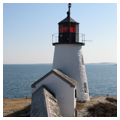With a rugged coastline and a long and fabled history of fishing and seafaring, Maine has the richest surviving inventory of lighthouses in America. Although seven of Maine’s early lighthouses, such as Saddleback Ledge (1839) and Matinicus (1847), were designed by noted Boston architects such as Alexander Parris, most involved no professional architect. Built by the United States Lighthouse Service (LHS) at the entrance to Boothbay Harbor in 1821, Burnt Island Lighthouse is a thirty-foot-tall, conical, white-painted rubblestone tower accompanied by a small stone, gable-roofed keeper’s house.
When built, the tower was crowned by a cast-iron lantern room housing ten whale oil lamps with parabolic reflectors. In 1857 the LHS installed a Fresnel 4th order lens, which was illuminated by an Aladdin kerosene-powered lamp. In the same year, the LHS replaced the small keeper’s house with a larger, two-story Victorian house with a side-gable roof and clapboard siding. Still extant, the house has two rear dormers and a single front dormer over a front porch. An enclosed clapboard-sided walkway connects the house and the tower. In 1961 an electric lamp replaced the kerosene model and in 1981 the United States Coast Guard (which replaced the LHS in 1939) automated the lighthouse.
Unmanning the lighthouses meant that the Coast Guard divested itself of the lighthouse infrastructure. In 1992 the Coast Guard announced its plans to begin the disposal process, raising the question of preservation. In the 1980s the Maine Historic Preservation Commission had listed thirty-eight of Maine’s lighthouses on the National Register of Historic Places (including Burnt Island) and in 1996 Maine’s Senator George Mitchell, together with Senator Olympia Snow, introduced legislation to establish the Maine Lighthouse Program, whereby twenty-four lighthouses were transferred to non-profit organizations and educational institutions. Currently, the Maine Department of Marine Resources owns, manages, and interprets Burnt Island Light.
Today many of Maine’s lighthouses are run by non-profits and offer educational programming. Burnt Island invites the public to spend time learning about the lighthouse and its keeper, in addition to touring the beautiful lighthouse grounds. During the summer months, excursion boats in Boothbay Harbor regularly bring visitors to Burnt Island.
References
D’Entremont, Jeremy. “New England Lighthouses: Burnt Island Light, Boothbay Harbor, Maine.” New England Lighthouses: A Virtual Guide. 2013. http://www.newenglandlighthouses.net/.
Mohney, Kirk F. Historic Preservation of Maine Lighthouses. Unpublished manuscript, 2015. Maine Historic Preservation Commission Library, Augusta, ME.























